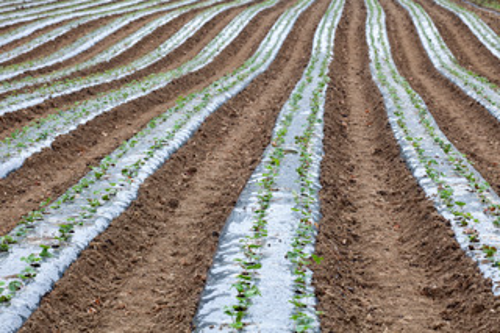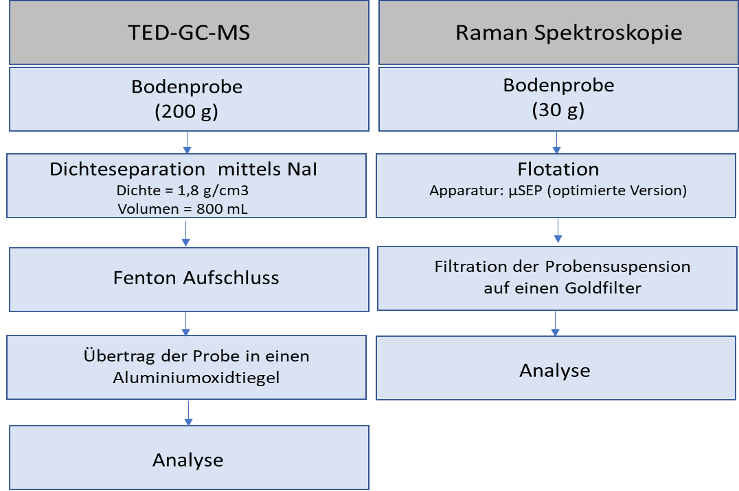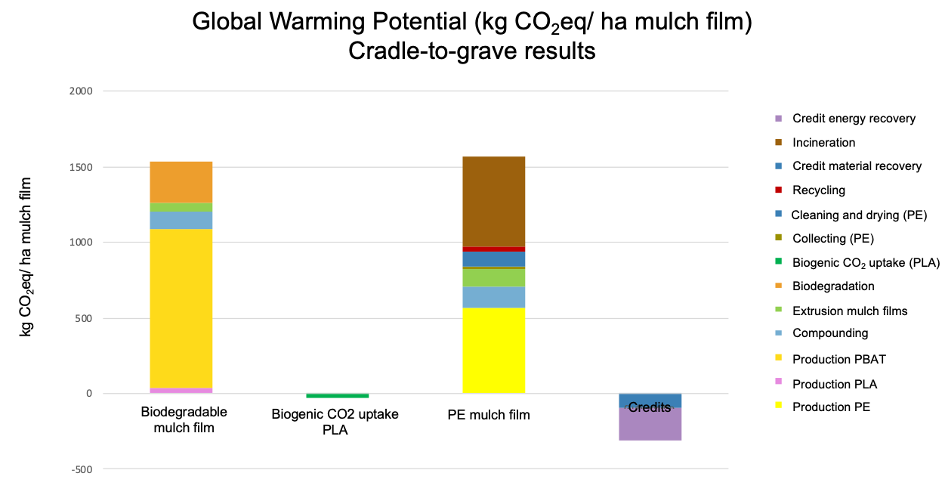
Plastics enter our soils directly or indirectly. A widespread example for the use of plastics on soils, that can lead to direct plastic input, is mulch films. Specifically in agricultural areas, mulch films are frequently used on farmland where they serve to regulate temperature and moisture in the soil, prevent weed growth and soil erosion during heavy rainfall, and protect crops from pests and predators. Due to the developing course of climate change and the targeted reduction of pesticides, experts expect a steadily increasing use of mulch films in agriculture. The joint project “iMulch – An investigation of the influence of polymers on a terrestrial ecosystem using the example of mulch films used in agriculture” examined possible negative effects of this development from a multi-perspective approach.
With this goal in mind, the project examined a petroleum-based (PE) film and two biodegradable plastic films (PLA/PBAT blend). A comparison of the films intended to clarify whether and to what extent biodegradable films offer ecological advantages compared to conventional films.

Weathering, ageing, transport behaviour and possible ecotoxicity
To enable sufficient assessment, iMulch researched the weathering and ageing of the films, their transport behaviour and possible ecotoxicity. The project-scope also included a life cycle assessment and an attempt to identify alternative recycling paths through upcycling. In order to reduce plastic emissions from mulch films in the environment in the future, the researchers derived various recommendations based on their generated results.
With the help of a laboratory-scale test sewage treatment plant filled with the drainage water from an arable field, the team conducted various weathering and ageing tests with conventional and bio-based mulch films. Here, the bio-based PLA/PBAT mulch films showed clear signs of weathering and partial decomposition after about six to eight weeks. In contrast, conventional PE films mainly showed fouling by microorganisms (biofouling). Fouling led to a clear increase in density over time for both types of film, which caused sedimentation of the film fragments in water bodies.
Finally, those responsible investigated the weathering of the mulch films in a soil test stand. In analogy to the experimental sewage treatment plant, they selected conventional and bio-based mulch films for this purpose. The samples were weathered on the soil under near-life environmental conditions with regard to soil moisture and air temperature. Generated results showed that the decomposition period for the biodegradable films lasted longer than initially expected by accelerated climatic chamber tests. However, complete degradation of these films could not be observed by the end of the trial (6 months). The PE film did not show any significant changes.
In order to analyse the transport and degradation behaviour of the polymers in the soil, the researchers synthesised PE and PLA/PBAT with a 14C-radioactive label, introduced them into the topsoil and investigated their transport using a lysimeter study. Under realistic field conditions, neither transport of both polymers, nor significant degradation of the biodegradable polymer, nor uptake of both polymers or their degradation products in plants could be detected after 24 months.
Adsorption tests with the heavy metal copper and three pesticides also showed no significant adsorption. Only for the pesticide tebuconazole did the tests determine a low adsorption in the case of the biodegradable films.
Toxicity tests conducted did not identify any negative effects on soil organisms in the context of reproduction tests. Investigations of the effects on aquatic organisms, on the other hand, showed an endocrine effect for both film types in in vitro tests, with films aged in a climate chamber showing a smaller effect. Differences in effect strength between the film types were also not detected.

Development of suitable measurement methods to determine the concentration, particle size, type and shape of various polymers in soil ecosystems
In order to be able to adequately examine the samples, the researchers first developed a suitable detection methodology. This included establishing and validating the sample preparation, analysis and evaluation method for TED-GC-MS and a suitable sample preparation and analysis method for RAMAN-spectroscopy. This enabled subsequent determination of the concentration, size distribution, morphology and type of polymers in soils.
Using the established TED-GC-MS method, the team analysed different soil samples from known farming systems. It was assumed that different types of cultivation, such as cultivation with and without mulch film and with biodegradable mulch film and conventional asparagus film, lead to different concentrations of PE or PLA/PBAT in soils. Measurements carried out as part of iMulch could not confirm this hypothesis. Regardless of the cultivation-type, seven of ten investigated soils showed PE concentrations < 1 µg/g, the other three concentrations between 4.4 and 9.7 µg/g. In five of the 10 soils, small amounts of PLA/PBAT could be detected, the values were between 0.3 and 2.6 µg/g soil, for the other soils the concentration was below the determination limit of 0.1 µg/g.
Statements on material and particle size distribution using RAMAN-spectroscopy
In order to be able to make statements about particle size and particle shape, the team further developed a method for the RAMAN-spectroscopy. The workflow could be (partially) automated so that, in addition to the particle identification, statements could be made about the material and particle size distribution as well as the particle shape. The investigations detected small amounts of microplastics of different species in all soil samples examined. However, a (time) limiting factor in the use of this measurement technique was the high matrix load of the soil samples. Although the matrix separation could be significantly improved during the project work, high heterogeneity of terrestrial soil matrices still poses a major problem. In addition to one plastic particle, this includes more than 200 other soil matrix particles in the processed samples. Conversely, 200 particles have to be spectroscopically analysed to find one plastic particle. An economical use of RAMAN-spectroscopy therefore requires an increase in the efficiency of sample preparation.

Life cycle assessment of PE and biodegradable mulch films using life cycle analysis
For the life cycle assessment, first a life cycle analysis (LCA) was carried out. As a functional unit, the scientists chose 1 ha of mulch film for the cultivation of courgettes for both mulch film types (biodegradable and conventional, for one cultivation season). For this purpose, they conducted a cradle-to-grave study that included all relevant steps from raw material procurement to biodegradation in the soil (for the biodegradable film) as well as recycling or incineration with energy recovery (for the conventional film). In terms of their impact on climate change, the conventional PE mulch films performed better in comparison to the biodegradable mulch films, given the case that credits from energy and material recycling at the end of the life cycle were taken into account. Only taking into account the process impacts, both mulch film types showed a similar balance. Yet, the team identified potential for savings in greenhouse gas emissions particularly with the use of bio-based adipic acid for the synthesis of PBAT and an increase in the recycled content of the PE film.

Microbial upcycling as a future path
Another work-focus was the possible upcycling of the films. Within the project-framework, it was possible to degrade biodegradable film fragments using special microorganisms and to build up new substances for a possible polymer production. The microorganisms, on the other hand, were unable to degrade or convert the examined PE.
Recommendations for the use of mulch films
Based on the test results, the team derived various recommendations aimed at reducing the input of plastic film fragments into the environment and hereby lower the emission of used mulch films. In general, the researchers recommend the use of biodegradable films. Nevertheless, proof of degradability under real outdoor conditions should be additionally verified. Particularly when using very thin conventional films, fragment loss is to be expected after use. In case of recovery of mulch films after use without material loss, the team recommends the use of thicker conventional mulch films. For this purpose, a minimum lower limit of material thickness could be defined to be used on agricultural land in the future. For the salvaged films, on the other hand, the development of suitable recycling concepts is recommended.
Another possibility is to increase the film thickness of biodegradable films so that they can be collected from the fields after use. Should individual fragments nevertheless remain on the soil, they can be ploughed under and degraded over time. The production of biodegradable mulch films with the same material thickness as conventional mulch films was proven to be economically currently not feasible. For this scenario, government incentives might have to be created in the future.
Detailed project results are available on the project website http://imulch.eu.
Concentrated expertise for effective research
The iMulch project is a Leitmarkt.NRW project and was funded by the European Regional Development Fund (EFRE) “Investment for Growth and Employment”. The consortium of the joint project comprises six active project partners and was accompanied by three associated partners. In addition to the company Fischer GmbH, the Fraunhofer Institute for Molecular Biology and Applied Ecology (IME), the Fraunhofer UMSICHT Institute, the nova Institute and the RWTH Aachen University with the respective Institutes for Environmental Research (IUF) and the Institute for Applied Microbiology (iAMB) were involved. The project was lead by the Institute for Energy and Environmental Technology e. V. (IUTA). BASF, the Research Institute Plastics and Recycling (FKuR Kunststoff GmbH) and the German Federal Environment Agency participated as associated partners. In addition, there was a lively exchange with the NRW Chamber of Agriculture.
Source
nova-Institute, press release, 2023-01-06.
Supplier
BASF Corporation (US)
by Dr. Björn Fischer - FISCHER GmbH
Europäischer Fonds für Regionale Entwicklung (EFRE)
FKuR Kunststoff GmbH
Fraunhofer-Institut für Molekularbiologie und Angewandte Ökologie (IME)
Fraunhofer-Institut für Umwelt-, Sicherheits- und Energietechnik (UMSICHT)
Institut für Energie- und Umwelttechnik e.V. (IUTA)
nova-Institut GmbH
RWTH Aachen – Institut für Angewandte Mikrobiologie (iAMB)
RWTH Aachen – Institut für Umweltforschung
Umweltbundesamt UBA
Share
Renewable Carbon News – Daily Newsletter
Subscribe to our daily email newsletter – the world's leading newsletter on renewable materials and chemicals













